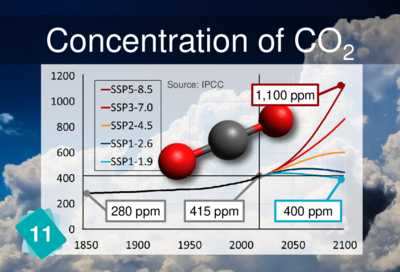En-en adult card 11 concentration of co2: Difference between revisions
No edit summary |
|||
| (3 intermediate revisions by one other user not shown) | |||
| Line 1: | Line 1: | ||
== Card #11: Concentration of CO<sub>2</sub> == | |||
| | <center> | ||
[[File:En-en_adult_card_11_front.png|400px]] | |||
About half of CO<sub>2</sub> emissions are captured by natural carbon sinks. The other half remains in the atmosphere. The concentration of CO<sub>2</sub> | |||
in the air has increased from 280 to 415 ppm (parts per million) over the past 150 years. This is higher than at any point over the last three million years. | |||
</center> | |||
== Explanation== | |||
CO<sub>2</sub> measurements have been taken since 1958 in Hawaii, on Big Island, on the flanks of the Mauna Loa volcano. They were initiated by Charles Keeling. In the blue scenario (2°C) they increase until 2040-2050, then they decrease because emissions will have been reduced so much that natural sinks no longer absorb them. | |||
== Correction== | == Correction== | ||
| Line 11: | Line 18: | ||
* [[En-en_adult_card_13_additional_greenhouse_effect|Additional Greenhouse Effect]] | * [[En-en_adult_card_13_additional_greenhouse_effect|Additional Greenhouse Effect]] | ||
== | == Wrong links== | ||
CO<sub>2</sub> | ===Wrong consequences=== | ||
*[[En-en adult card 12 carbon sinks|Carbon sinks]] It can be argued that CO<sub>2</sub> emissions take place before reaching carbon sinks. But the opposite link has our preference. | |||
*[[En-en adult card 24 ocean acidification|Ocean acidification]] Players often identify CO<sub>2</sub> concentration as a cause for ocean acidification. But it is more logical to link back to carbon sinks. | |||
== To go further == | ==To go further== | ||
=== CO<sub>2</sub> elimination === | ===CO<sub>2</sub> elimination=== | ||
The surplus CO<sub>2</sub> is permanently stored in the atmosphere (no chemical degradation process). There are only 2 physical processes: dissolution of CO<sub>2</sub> in the oceans, and synthesis of | The surplus CO<sub>2</sub> is permanently stored in the atmosphere (no chemical degradation process). There are only 2 physical processes: dissolution of CO<sub>2</sub> in the oceans, and synthesis of O<sub>2</sub> via photosynthesis (in the presence of photons). | ||
Therefore<ref>[https://www.ipcc.ch/site/assets/uploads/2018/02/WG1AR5_all_final.pdf#page=489 IPCC Climate Change 2013 Report]</ref>: | Therefore<ref>[https://www.ipcc.ch/site/assets/uploads/2018/02/WG1AR5_all_final.pdf#page=489 IPCC Climate Change 2013 Report]</ref>: | ||
* in 100 years' time, 40% of the surplus CO<sub>2</sub> released today will still remain in the atmosphere | *in 100 years' time, 40% of the surplus CO<sub>2</sub> released today will still remain in the atmosphere | ||
* in 1000 years' time, 20% of the surplus CO<sub>2</sub> emitted today will still remain in the atmosphere | *in 1000 years' time, 20% of the surplus CO<sub>2</sub> emitted today will still remain in the atmosphere | ||
* in 10,000 years' time, 10% of the surplus CO<sub>2</sub> emitted today will still remain in the atmosphere. | *in 10,000 years' time, 10% of the surplus CO<sub>2</sub> emitted today will still remain in the atmosphere. | ||
It is an almost irreversible process. | It is an almost irreversible process. | ||
=== French emission factors === | ===French emission factors=== | ||
In France, the main cause of CO<sub>2</sub> emissions has shifted from industry to transportation in 150 years. | In France, the main cause of CO<sub>2</sub> emissions has shifted from industry to transportation in 150 years. | ||
== References == | ==References== | ||
<references /> | <references /> | ||
[[fr:Fr-fr_adulte_carte_11_concentration_en_co2]] | [[fr:Fr-fr_adulte_carte_11_concentration_en_co2]] | ||
Latest revision as of 22:56, 27 October 2022
Card #11: Concentration of CO2
About half of CO2 emissions are captured by natural carbon sinks. The other half remains in the atmosphere. The concentration of CO2 in the air has increased from 280 to 415 ppm (parts per million) over the past 150 years. This is higher than at any point over the last three million years.
Explanation
CO2 measurements have been taken since 1958 in Hawaii, on Big Island, on the flanks of the Mauna Loa volcano. They were initiated by Charles Keeling. In the blue scenario (2°C) they increase until 2040-2050, then they decrease because emissions will have been reduced so much that natural sinks no longer absorb them.
Correction
Causes
Consequences
Wrong links
Wrong consequences
- Carbon sinks It can be argued that CO2 emissions take place before reaching carbon sinks. But the opposite link has our preference.
- Ocean acidification Players often identify CO2 concentration as a cause for ocean acidification. But it is more logical to link back to carbon sinks.
To go further
CO2 elimination
The surplus CO2 is permanently stored in the atmosphere (no chemical degradation process). There are only 2 physical processes: dissolution of CO2 in the oceans, and synthesis of O2 via photosynthesis (in the presence of photons).
Therefore[1]:
- in 100 years' time, 40% of the surplus CO2 released today will still remain in the atmosphere
- in 1000 years' time, 20% of the surplus CO2 emitted today will still remain in the atmosphere
- in 10,000 years' time, 10% of the surplus CO2 emitted today will still remain in the atmosphere.
It is an almost irreversible process.
French emission factors
In France, the main cause of CO2 emissions has shifted from industry to transportation in 150 years.
